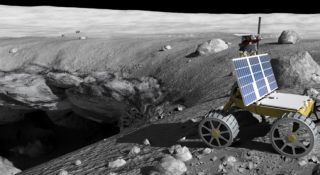Click here if you want to read this page in Spanish![]()
China explores the Moon since the “Chinese National Space Administration” (CNSA) undertook the Chang’e Project with the firm intention of initiating a program of robotic exploration and manned missions to the Moon.
China explores the Moon with the Chang’e Project
The Chang’e Project is named after the Chinese goddess Chang’e who, according to legends, lives on the Moon.
The Chinese Lunar Exploration Program began in 2007, with the launch of the first probe that orbited the Moon.
It is expected that in the year 2036, the Chang’e project will be able to reach the Moon with a manned mission.
The objectives set in the short and medium term are:
- Orbit around the Moon
- Land
- Collect and bring samples to Earth
- Manned moon landing.
For robotic exploration, it is planned to use lunar orbiters, lunar robots and probes that bring samples of lunar soil to Earth.
For manned missions, the Chinese National Space Administration prepares a spacecraft named Shenzhou.
The ground control of the missions is carried out through a “Deep Space Tracking Network“, made up of 50 m diameter antennas in Beijing, and 40 m in Kunming, Shanghai and Ürümqi.
For the launches, an adapted version of the “Long March” rocket has been used.
China explores the Moon with the Chang’e 1 probe
The first mission of the program was Chang’e 1, an unmanned lunar orbiter, launched on October 24, 2007 from the Xichang Space Center.
Chang’e 1 entered lunar orbit on November 5, 2007, and spent 16 months orbiting the Moon. It crashed on the lunar surface on March 1, 2009.

Chang’e-1 sent China the first complete map of the Moon’s surface.
A dozen performance tests were carried out while Chang’e-1 was in orbit to find out its orbit tuning capabilities.
Chang’e-1 had been slowing down under the remote control of two observation and control stations: one in Qingdao, eastern China; the other in Kashi, in northwestern China.
The Chang’e 2 probe
The Chang’e 2 probe left for the Moon on October 1, 2010.
The objectives of the Chang’e-2 mission were:
- Enter lunar orbit ,without first settling in an Earth orbit.
- Test the technology of capturing the Moon from 100 km away.
- Improve the high-speed data transmission system between the Moon and the Space Control Center.
- Improve the accuracy and precision of lunar science data.
- Obtain three-dimensional images of the lunar surface, especially of Sinus Iridum, a possible landing site for Chang’e3.
- Study the composition of the material on the lunar surface.

Photo of the Chang’e-2 spacecraft at the Xichang Satellite Launch Center. Credit: CAST, eoportal.org website
Chang’e 2’s mission was to orbit the Moon in order to collect data that would facilitate the landing of robots and humans on subsequent missions.
After completing its mission, Chang’e-2 continued on its way to space, to test China’s spacecraft monitoring and control network.
On July 14, 2013, the Chang’e-2 probe had reached a distance of 50 million kilometers from Earth, marking a new height in deep space exploration.
In 2015, Chang’e-2 was more than 100 million kilometers from Earth.
The Chang’e 3 probe
Three years later, everything was ready for the Chang’e 3 probe, to land on the Moon.
Chang’e 3 was released on December 2, 2013.

After two weeks, on December 14, 2013, the probe successfully landed in the most spectacular and beautiful bay on the Moon, the Rainbow Bay, Sinus Iridum.
The Rainbow Bay is located northwest of Mare Imbrium, Sea of Rain, and is visible even with binoculars.
The Sinus Iridum is an impact crater 250 km in diameter, which lost its southeast wall, thus forming a bay.
With the soft landing of Chang’e 3, a period of 37 years without exploration of the lunar surface ended, since the arrival of the Moon 24 probe from the Soviet Union, in 1976.
The Chang’e 4 probe
On December 7, 2018, the Chinese Space Administration launched Chang’e 4, bound for the far side of the Moon.
The probe successfully landed on January 3, 2019, depositing a rover robot named Yutu-2 on the lunar surface.
With this triumph, China became the first nation to achieve a controlled landing on the far side of the Moon.

Communications between the probe and Earth were made possible by a satellite, Queqiao, previously put into orbit and operating as a “mirror”, transmitting information between the control centers on Earth and Chang’e 4.
The robotic ship Chang’e 5
The Chang’e 5 robotic spacecraft took off on November 23, 2020, from the Wenchang Space Center on Hainan Island, bound for our satellite.
Chang’e 5 landed on December 1, 2020, in the area known as Oceanus Procellarum, a large, 70-km-diameter elevated volcanic mound of basaltic material, located in the northwestern region of the Moon’s visible face.
The main objective of this mission was to collect samples of the lunar soil, and bring them to Earth.

The Chinese authorities immediately offered the first images of this new historical milestone, as it is the most complex space mission undertaken by China.
A robotic arm drilled the surface, making a hole 2m deep; and collected about two kilos of rocks and lunar debris.
The samples were transferred to a vehicle that ascended to dock with an orbiter module that later brought that material to Earth, 23 days later when it landed in Mongolia.
A 24-year-old girl, Zhou Chengyu, with the rank of program commander, was in charge of the rocket connection and control system.

China planted its starry red flag on the Moon, more than 50 years after the United States did.
The images were taken by a camera located on the Chang’e-5 spacecraft, shortly before leaving the Moon.




